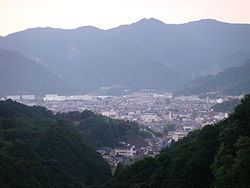Country Japan - Tree Hinoki - Bird Grey heron Population 17,953 (Aug 2015) Prefecture Mie Prefecture | Region Kansai, Tōkai - Flower Japanese camellia Area 192.7 km² Local time Wednesday 3:33 AM Bird Grey heron | |
 | ||
Time zone Japan Standard Time (UTC+9) Weather 6°C, Wind NW at 6 km/h, 86% Humidity Points of interest Kumano Information Centre, Owase Shrine, Kongoji, Mt Takamine | ||
Owase (尾鷲市, Owase-shi) is a city located in Mie Prefecture, Japan.
Contents
- Map of Owase Mie Prefecture Japan
- Geography
- Neighboring municipalities
- History
- Economy
- Education
- Railway
- Highway
- Port
- Climate
- Local attractions
- Festivals Events
- Sister city relations
- Noted people
- References
Map of Owase, Mie Prefecture, Japan
As of August 2015, the city had an estimated population of 17,953 and a population density of 93.2 persons per km2. The total area was 192.71 square kilometres (74.41 sq mi).
Geography
Owase is located in southeastern Kii Peninsula, in southern Mie Prefecture, facing the Pacific Ocean. Ninety percent of the city area is forested or coastal rias
Neighboring municipalities
History
The area of present-day Owase was part of ancient Shima Province, but was transferred to Kii Province in 1582. During this time, large-scale forestry projects were begun. The town of Owase was established on April 1, 1889 within Kitamuro District of Mie Prefecture.
The modern city of Owase was established on June 20, 1954 by the merger of the town of Owase with the surrounding villages of Sugari and Kuki and the villages of Kitawauchi and Minamiwauchi (both from Minamimuro District).
Economy
Due to its location, Owase is mainly supported by its commercial fishery and forestry industries. Yellowtail, amberjack, Japanese horse mackerel, sauries, sea bream and bonito are among the fish landed at Owase. Japanese cypress and cryptomeria trees are found in abundance here in the mountains.
Education
Owase has seven elementary schools, two middle schools, one high school and one special education school.
Railway
Highway
Port
Climate
Owase has a humid subtropical climate (Köppen climate classification Cfa), with comfortable spring and autumn seasons, and warm winters with practically no snow. The warm Kuroshio Current makes its closest contact with the Japanese coast at Owase, and combined with the high mountains falling almost to the sea, this gives Owase an extremely heavy annual rainfall of 3,850 millimetres (150 in), which is the highest in the world at low altitudes in subtropical and warm temperate latitudes. Only certain parts of southern Chile, coastal British Columbia and the Adriatic Sea coast have as much rain at low elevations outside the tropics.
Despite the excessive wetness of the climate, summers are no more uncomfortable or humid than in the rest of southern Japan: indeed humidity is marginally lower than on cities close to the Seto Inland Sea or on the southern Sea of Japan.
